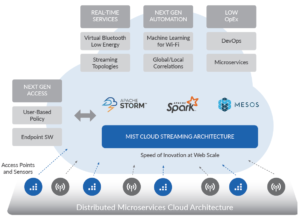
AI Now Infused In Network and Wi-Fi Management

(dolphfyn/Shutterstock)
The days of manually troubleshooting networking problems may soon be over if the announcements today from Cisco and Mist are any indication. The two vendors today each debuted new offerings that employ artificial intelligence technologies to simplify the management of Wi-Fi and wired networks.
Cisco Systems used an event in Barcelona, Spain to introduce what it dubs its “second wave of intent-based networking innovation, that includes new “assurance technologies.”
Specifically, the company is rolling out the Cisco Network Assurance Engine, which uses mathematical modeling and predictive analytics to accomplish a range of tasks, including predicting the impact of changes; continuously verifying network behavior; and checking for security and compliance risks.
“Today, IT teams spend 43 percent of their time troubleshooting network issues,” Cisco’s Scott Harrell says in a blog post. “They are challenged with finding the proverbial needle in a haystack. There are over 100 places where things can go wrong between the user and application and, as a result, IT spends 4X more time collecting data as they do analyzing and resolving the issue.
Cisco says these new “assurance” capabilities are like a “sixth sense” and let network managers “travel back in time.” In a marketing video, Cisco shows a networking executive calmly dealing with a barrage of networking problems from her phone while she walks down a busy city street.

Cisco says the new “assurance” capabilities in its “intent-based” networking gear functions like a “sixth sense”
“What if my network could be intuitive, like my senses, recognizing patterns, instantly processing information, making split-second decisions, and gaining context by clearly seeing the big picture?” the executive says. “Well you can with intent-based networking from Cisco.”
Meanwhile, the AI announcement from Mist Systems went a little lighter on the supernatural mysticism and heavier on practical explanations of how AI can be applied to a wireless environment and what it means for real users.
Mist — an early stage Silicon Valley networking venture that develops wireless and Bluetooth networking hardware and software – previously built big data capabilities into its network offerings.
The company is already able to gather up to 100 pieces of metadata every two seconds from every wireless device connected to its access points (AP), and move it into its cloud for analysis. It already has a machine learning engine, called Marvis, that makes sense of the data, spots anomalies, and predicts potential problems on behalf of customers.
What it did today was launch a new product called the Virtual Network Assistant (VNA) that use natural language processing (NLP) to enable a networking professional to verbally query Marvis and find out things about their Mist gear that might otherwise require digging in a traditional console.
“It’s like Alexa for IT,” says Mist’s Vice President of Marketing Jeff Aaron.
Aaron explains how it works. “In the past, if you had an issue with the Wi-Fi, you call the helpdesk,” he says. “The first thing they say is ‘What’s your MAC address?’ You say, ‘I don’t know.’ So they have to work with you to dig up MAC address.

Mist Systems used a variety of open source technologies to architect its cloud-based AI system for streamlining Wi-Fi management
“Then they’re going to query the system,” Aaron continues. “They’re going to pull up a bunch of event logs. They’re going to have to manually correlate what all that means. It’s just a nightmare to troubleshoot.”
With VNA as a front-end to Marvin, Mist is simplifying the whole process. The software (which works with Mist’s access points as well as some networking hardware from Cisco) lets helpdesk professional make verbal simple queries, such as “What’s happening with Bob’s iPhone?” or “What happened in the conference room last week?” or “How many iOS devices do I have on my network right now?” The system then presents the results back to the user.
VNA can be used by either the helpdesk folks or the networking professionals, Aaron says. In either case, the AI microservice will do the hard work of gathering the relevant data, correlating it to spot patterns, and then determining the cause of the problem, such as whether it’s a connection issue, a bandwidth issue, or networking issue.
“If I’m a help desk guy, I don’t need to understand what all this means. But I have all the data here to tell me what’s going on so I can quickly troubleshoot,” he says. “So someone who’s not a networking or wireless professional doesn’t need to know all that high degree of information to get the data to trouble shoot.”
Mist VNA uses a variety of open source big data technologies to make this happen, including Apache Kafka for moving data, Apache Storm for analyzing data flows, and Apache Spark to develop proprietary machine learning algorithms. Various data stores run in Redis, PostgreSQL, and Cassandra, while Mesos and Zookeeper keep things loosely separated yet tightly integrated.
Aaron says the advent of modern cloud, big data, and AI technologies enable Mist to build networks that just weren’t possible a decade ago. “There’s’ a whole new market opportunity for a complete new Wi-Fi system that’s way simpler, more predictable, and more reliable,” he says, “and that’s what we’ve built.”
Related Items:
Hidden Anomalies No Match for LivePerson’s Machine Learning Engine
The Network is the New Storage Bottleneck
Closing the Big Data Networking Gap



























